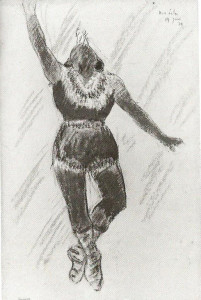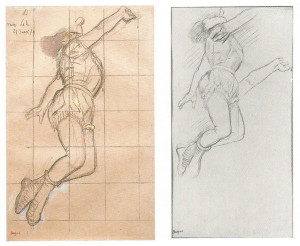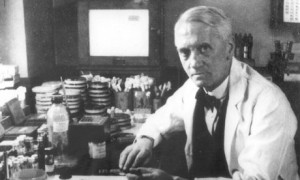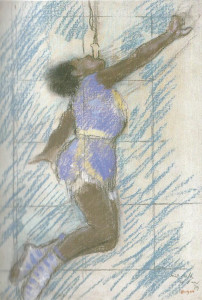Art vs. science: a closer look
January 9, 2014
Following on from my previous article, let’s now look more closely at the approaches of scientists and artists. Can they really have much in common? I’ll start by outlining scientific procedure, and then see how the artistic process compares.
Scientific procedure
Oxford English Dictionary definition of “scientific”: “a method or procedure that has characterized natural science since the 17th century, consisting in systematic observation, measurement, and experiment, and the formulation, testing, and modification of hypotheses.”
Above: Alexander Fleming in his lab, surrounded by petri dishes, etc.
Observation:
Many lines of scientific enquiry (especially novel, ground-breaking ones) start with an interesting observation. This is a process of “noticing something curious” and does not necessarily occur under controlled laboratory conditions.
For example, in 1928, Alexander Fleming noticed something odd about an open petri dish in his lab. This was a petri dish known to contain bacteria. What struck Fleming as interesting was a mysterious ring without bacteria on this dish. And surrounded by this bacteria-free halo was a growth of mould.
Admittedly, not every single scientific investigation starts with an observation. Some may begin with a need to solve a problem. Consider the many scientific trials involved in producing a medical drug these days. But even when using more of a problem-solving approach, the scientific process of observing and thinking at each stage of the development of the drug is essential.
Note that The “systematic observation” included in the OED definition usually comes later, at the testing stage of the process.
Coming up with a question:
Every line of scientific investigation involves a question. E.g. “Why does this happen?”, “How does that work?”, “Does that treatment work?”, “Why was that set of results not as expected?”, etc., etc.
Fleming’s question would have been something like, “why is bacteria not growing around the mould?”
Curious, he sampled and cultured the mould and identified it as a species of Penicillium.

Above: a species of Penicillium as seen through a microscope
Making a hypothesis:
Using any information to hand, the scientist comes up with a hypothesis, i.e. a suggested answer to their question. In many cases, the hypothesis is simply an educated guess.
An initial hypothesis in the above example might have been, “This Penicillium mould inhibits bacterial growth”. (This turns out to be exciting, as the story eventually leads to the creation of the antibiotic, Penicillin).
Testing:
Any hypothesis needs rigorous testing.
Following initial observations, it would be necessary to conduct an experiment using multiple agar plates seeded with a known type of bacteria. A pure growth of the Penicillium mould would be seeded onto just half of the plates. We’d predict that bacterial growth would be inhibited only on the plates containing the mould. Lids are kept on this time, as we need to know whether any inhibition of bacterial growth is due to the mould or instead merely due to some other environmental contaminant. Temperature and other conditions are strictly controlled, and careful, systematic observations made and recorded.
Results are then analysed,
and a decision is made as to whether the hypothesis is valid.
These days, each scientific discovery must be presented as a paper (there are close guidelines as to how this should be written), and this piece of writing must then go through peer-review (expert criticism) before publication.
A response to the results:
The results of the initial experiment may set the scientific community wondering about further possibilities…
E.g. “I wonder if the Penicillium inhibits all species of bacteria on agar plates” or, eventually, “I wonder if the Penicillium would work in the human body to cure bacterial disease”. Each new thought leads to a fresh hypothesis that then requires rigorous testing.
Above: The life-saving drug, Penicillin, was developed from Penicillium mould in 1939 by Dr Howard Florey and his colleagues at Oxford University.
I have chosen the well-known story of Fleming’s discovery of Penicillin because of its emphasis on “noticing something” and “coming up with a question”. On further reading I have just found that, coincidentally or not, Fleming was also an amateur artist, a member of the Chelsea art society and is even believed to have drawn with bacteria!
How does artistic procedure compare with the above?
Observation/ Noticing things
Scientists may start their investigation by noticing curious phenomena in the real world or unexpected results from previous experiments.
But what do artists notice?
Anything in the real world that makes us “look twice” or leads us to think, “that’s interesting/ strange/ unexpected”, is a good starting-point for creating a piece of artwork. Artists are good at noticing something curious even in the most mundane situations (click here for further thoughts on this).
In figurative art, there is a particularly strong tradition of noticing:
Effects of the light
Human posture, how we move and how we spread our weight (think of all that closely-observed life-drawing)
Body language, facial expression and the minutiae of social interaction
But artists also notice their own emotional response to what they see and experience (including their response to news stories or even to fictional narrative), and this particular emotional response can be the basis of the resulting artwork.
Artists are great at noticing their own emotional response to colours, shapes, directional lines and movement, whether in the real world or within a picture, sculpture or film.
As an example, let’s take Edgar Degas and his creation of the painting, “Miss La La at the Cirque Fernando”. I’m choosing this because Degas is known to have gone through quite a struggle to create it, and several studies exist relating to different stages of the process.
Above: Edgar Degas “Miss La La at the Cirque Fernando”, oil on canvas
Miss La La was an incredibly strong, agile and brave performer who worked at the Cirque Fernando close to where Degas lived. Why did Degas choose to paint this image? What struck him as “interesting” or “incredible” about this scene? He is not here to tell us, but we know that he was fascinated by human movement, the structure of the female form and unusual juxtapositions of figures against their surroundings. He appears to have noticed the following, and then set out to include them in his final image:
Miss La La’s unique pose, which is a unique combination of passive hanging plus strong arms ready to control the spin of the rope
The amazing height that she’s achieved, far above the crowd
The shape of her against the architecture
Above: Edgar Degas : One of many preparatory drawings for Miss La La at the Cirque Fernando, 1879, pastel and pencil on paper, 46x30cm
Coming up with a question
Admittedly, questioning is a subconscious process for many artists, though I believe that it is an important part of working creatively.
In response to noticing something (see above), the artist comes up with a question. For those who draw and paint, this question can be rephrased as a practical one. Here are some examples of specific questions that artists might ask themselves:
In embarking on a self-portrait: “What is it about me that makes me recognisable as “me”?”
and then: “how can I draw myself so that the resulting self-portrait looks like me?”
In drawing people at work: “How do these people move? How do they interact with each other?”
and then: “how can I capture the movement of these people in my drawing?”
In drawing a still life, the question might be: “Why does this vase of flowers make me feel joyful?”
and then: “how can I convey this sense of joy in my painting of the flowers?”
Note that the artist may need to ask and answer several questions before creating a complex image such as “Miss La La…”.
Degas made separate preparatory studies relating to the figure and the architecture for this image. It is said that he struggled to resolve the shapes of the architecture, possibly even hiring professional help to get this right (D.Sutton, “Edgar Degas, Life and Work, NY1986). But let’s look at the issue of the figure hanging from the rope. What question might Degas have asked himself?
“Hanging from the rope, why does Miss La La look both passive and strong?” or he might have asked , “How is she managing to hang from the rope without spinning out of control?”
For the painter, either of these questions leads onto a practical drawing/painting question:
“How can I paint Miss La La hanging from that rope so that she looks both passive and strong?” or perhaps, “How can I draw/paint Miss La La so that she appears to be hanging, and yet perfectly controlling the rope spin?”
Degas was experienced at painting dancers and athletes on the ground, but this was a new problem for him…
A thought similar to a hypothesis
Unlike scientists, artists are not expected to write a formal hypothesis! But the thought process can nevertheless be similar.
Back to Degas and Miss La La:
Degas might have thought, “I reckon that if I draw Miss La La with her upright body position, relaxed bent knees, feet pressed against each other and strong, out-stretched arms, then she will look convincing as someone who is passively hanging but yet controlling the spin of the rope”
Testing
There are exceptions but, unlike scientists, artists do not tend to put their ideas through a rigorous, controlled test process. This is one big difference between the process of art and science.
Preparatory studies and sketches are, however, a form of testing.
 Above: Degas, an early study of Miss La La (drawn with upright body position, relaxed bent knees, feet pressed against each other and strong, out-stretched arms), Black crayon 45.6x24cm, 1879
Above: Degas, an early study of Miss La La (drawn with upright body position, relaxed bent knees, feet pressed against each other and strong, out-stretched arms), Black crayon 45.6x24cm, 1879
An early study for the painting of Miss La La (shown above) has her facing the viewer. It is a powerful image but, in my opinion (and Degas’ too, as he rejected this viewpoint), it fails to show the spin-controlling power of the woman’s shoulders and arms. (Additionally, this viewpoint fails to show how high she is above the crowd).
What next?
Degas’ next “hypothesis” was that he could perhaps achieve the controlled dangling effect if he clarified the position of the woman’s arms. Those arms would have a big effect on her speed and direction of spin beneath the rope.
He proceeded to test this by drawing her with the raised arm thrust forward and the lowered arm behind her back. The arms are also rotated (look at the positions of the hands):
 Above: Edgar Degas, two further preparatory studies for “Miss La La at the Cirque Fernando”, 1879
Above: Edgar Degas, two further preparatory studies for “Miss La La at the Cirque Fernando”, 1879
Analysing the results of the test
A good scientific study produces a set of objective results. Using statistical techniques, these results are analysed before the scientist can conclude anything from the study.
This varies tremendously from the artist’s approach. Artists do, however, evaluate their own work, even if just to say, “Yes, that produces the desired effect”. Though highly subjective, this evaluation process can be useful if applied to sketches or first drafts. Think of each sketch as testing something, and each evaluation process as assessing the result.
Above: Yet another study by Degas for the painting of Miss La La. Pastel, 61×47.5cm, 1879. This is very similar in structure to the squared-up image higher up the page, but this drawing also tests out colour ideas and the positioning of the rope end in her mouth. Notice how Degas squared this image up for future use though the figure then underwent yet more slight changes. Developing a piece of work through a series of preparatory studies can be a lengthy business.
A response to the results
Like scientists, good artists look at their own work, and that of others, and come up with further ideas. This may be a personal response to a masterpiece seen in a gallery, or a response to their own work.
It is particularly your own “failed” pieces of work that can generate useful new ideas. Notice Degas’ useful response to his early drawing of Miss La La shown face-on. He wasn’t happy with it, but worked out what to change.
Summary
“Noticing something interesting” is a key process for artists but is also important in making scientific discovery.
Both artists and scientists should be asking questions.
Coming up with a suggested answer to the question is useful for both artists and scientists. Scientists make a hypothesis. Some artists may find it helpful to think in a similar way.
Scientists test things in a very controlled, rigorous way. Artists also test things, but not necessarily in such a controlled manner.
Both scientists and artists respond to the outcome of their work in a positive way, and this may be a fresh starting-point for a new line of investigation or piece of work.
Error: Contact form not found.




